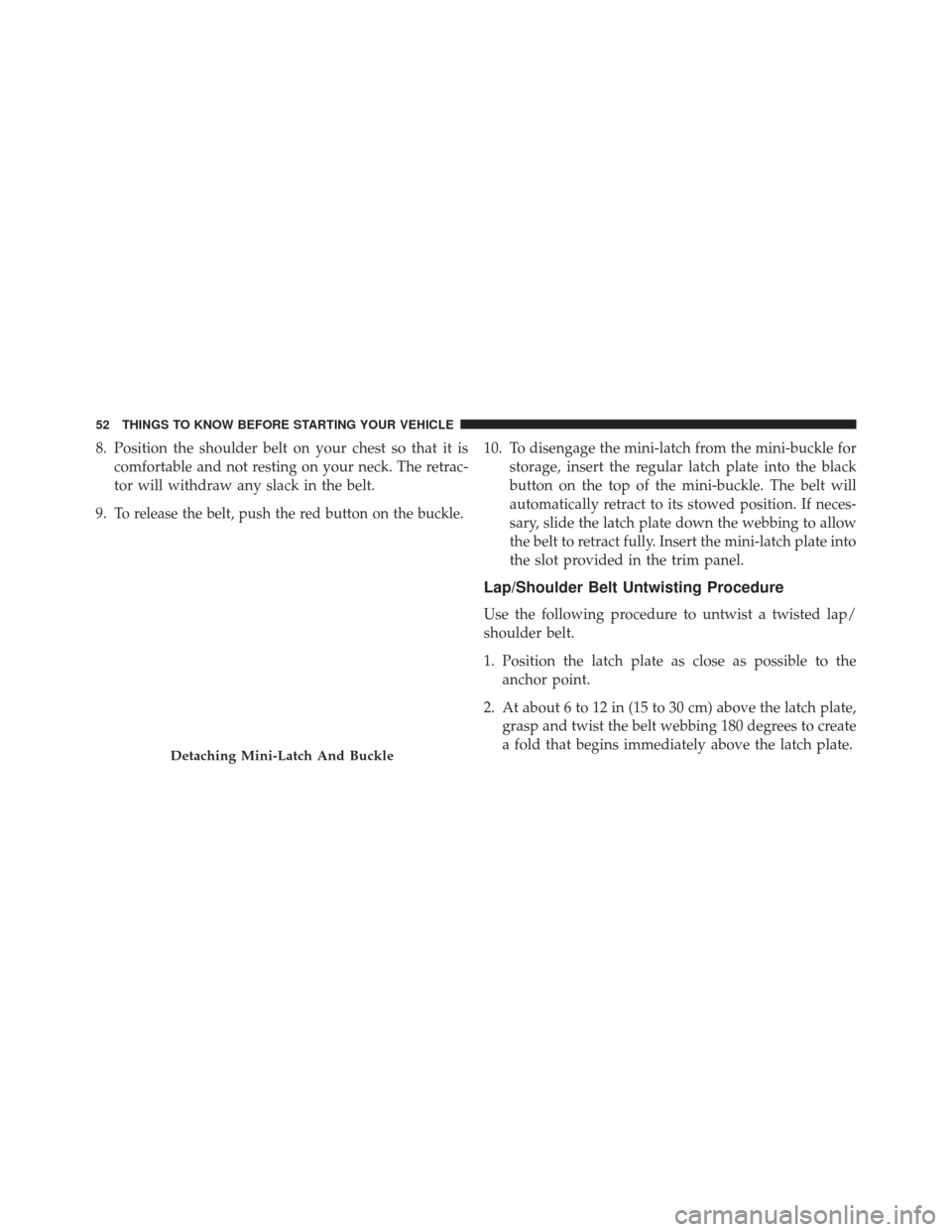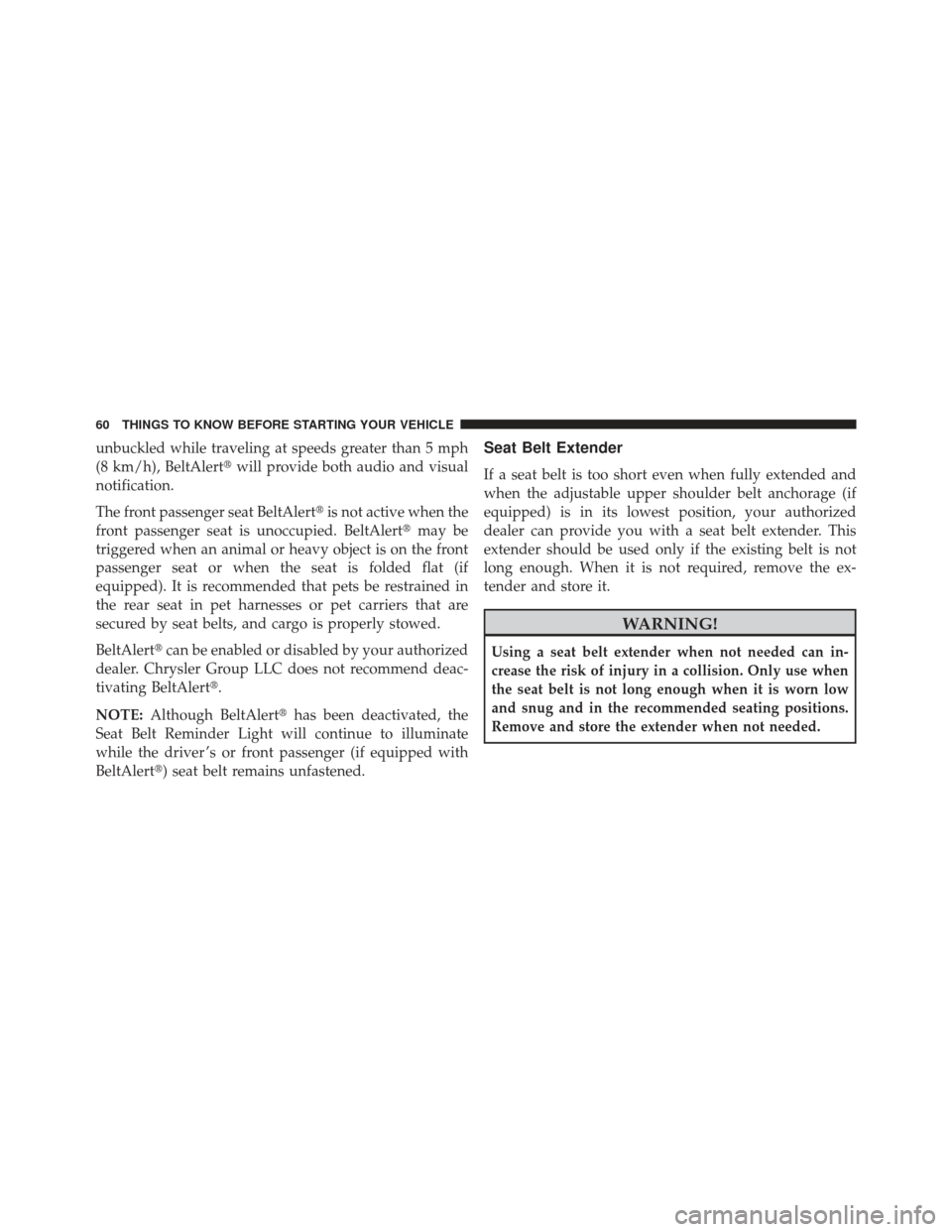Page 27 of 525
NOTE:Changes or modifications not expressly approved
by the party responsible for compliance could void the
user’s authority to operate the equipment.
If your RKE transmitter fails to operate from a normal
distance, check for these two conditions:
1. Weak battery in the RKE transmitter. The expected life of a battery is five years.
2. Closeness to a radio transmitter such as a radio station tower, airport transmitter, military base, and some
mobile or CB radios.
Transmitter Battery Replacement
NOTE:Perchlorate Material – special handling may apply.
See www.dtsc.ca.gov/hazardouswaste/perchlorate
The recommended replacement battery is CR2032. 1. If the RKE transmitter is equipped with a screw,
remove the screw. With the RKE transmitter buttons
facing down, use a flat blade screwdriver to pry the
two halves of the RKE transmitter apart. Make sure
not to damage the elastomer seal during removal.
Separating Case Halves
2
THINGS TO KNOW BEFORE STARTING YOUR VEHICLE 25
Page 50 of 525

6. To release the belt, push the red button on the buckle.The belt will automatically retract to its stowed posi-
tion. If necessary, slide the latch plate down the
webbing to allow the belt to retract fully.
WARNING!
A frayed or torn belt could rip apart in a collision and
leave you with no protection. Inspect the belt system
periodically, checking for cuts, frays, or loose parts.
Damaged parts must be replaced immediately. Do
not disassemble or modify the system. Seat belt
assemblies must be replaced after a collision if they
have been damaged (bent retractor, torn webbing,
etc.).
Adjustable Upper Shoulder Belt Anchorage
In the front seat, the shoulder belt can be adjusted
upward or downward to position the belt away from
your neck. Push the anchorage button to release the
anchorage, and move it up or down to the position that
fits you best.
NOTE: The adjustable upper shoulder belt anchorage is
equipped with an Easy Up feature. This feature allows
the shoulder belt anchorage to be adjusted in the upward
position without pressing the release button. To verify
the shoulder belt anchorage is latched, pull downward
on the shoulder belt anchorage until it is locked into
position.
48 THINGS TO KNOW BEFORE STARTING YOUR VEHICLE
Page 51 of 525
As a guide, if you are shorter than average you will
prefer a lower position, and if you are taller than averageyou will prefer a higher position. When you release the
anchorage, try to move it down to make sure that it is
locked in position.
In the rear seat, move toward the center of the seat to
position the belt away from your neck.
Second Row Center Lap/Shoulder Belt Operating
Instructions
The second row center lap/shoulder belt features a
three-point seat belt with a mini-latch and buckle, which
allows the shoulder belt to detach from the lower anchor
when the seat is folded. The mini-buckle and shoulder
belt can then be stored out of the way in the right side
trim panel for added convenience.
Adjustable Anchorage
2
THINGS TO KNOW BEFORE STARTING YOUR VEHICLE 49
Page 52 of 525
1. Remove the mini-latch and regular latch from itsstowed position in the right rear side trim panel.
2. Grasp the mini-latch plate and pull the belt over the seat.
3. Route the shoulder belt to the inside of the right head restraint. 4. When the belt is long enough to fit, insert the mini-
latch plate into the mini-buckle until you hear a
“click.”
5. Sit back in the seat. Slide the regular latch plate up the webbing as far as necessary to allow the belt to go
around your lap.
Mini-Latch Stowage
Routing The Rear Center Shoulder Belt
50 THINGS TO KNOW BEFORE STARTING YOUR VEHICLE
Page 54 of 525

8. Position the shoulder belt on your chest so that it iscomfortable and not resting on your neck. The retrac-
tor will withdraw any slack in the belt.
9.
To release the belt, push the red button on the buckle.
10. To disengage the mini-latch from the mini-buckle for storage, insert the regular latch plate into the black
button on the top of the mini-buckle. The belt will
automatically retract to its stowed position. If neces-
sary, slide the latch plate down the webbing to allow
the belt to retract fully. Insert the mini-latch plate into
the slot provided in the trim panel.
Lap/Shoulder Belt Untwisting Procedure
Use the following procedure to untwist a twisted lap/
shoulder belt.
1. Position the latch plate as close as possible to theanchor point.
2. At about 6 to 12 in (15 to 30 cm) above the latch plate, grasp and twist the belt webbing 180 degrees to create
a fold that begins immediately above the latch plate.
Detaching Mini-Latch And Buckle
52 THINGS TO KNOW BEFORE STARTING YOUR VEHICLE
Page 60 of 525
3.Pulldown thenrearward towards the rear of the vehicle
then down to engage the locking mechanism.
4. The AHR front soft foam and trim half should lock
into the back decorative plastic half.1 — Downward Movement
2 — Rearward Movement
3 — Final Downward Movement To Engage Locking Mechanism
58 THINGS TO KNOW BEFORE STARTING YOUR VEHICLE
Page 62 of 525

unbuckled while traveling at speeds greater than 5 mph
(8 km/h), BeltAlert�will provide both audio and visual
notification.
The front passenger seat BeltAlert� is not active when the
front passenger seat is unoccupied. BeltAlert �may be
triggered when an animal or heavy object is on the front
passenger seat or when the seat is folded flat (if
equipped). It is recommended that pets be restrained in
the rear seat in pet harnesses or pet carriers that are
secured by seat belts, and cargo is properly stowed.
BeltAlert� can be enabled or disabled by your authorized
dealer. Chrysler Group LLC does not recommend deac-
tivating BeltAlert�.
NOTE: Although BeltAlert� has been deactivated, the
Seat Belt Reminder Light will continue to illuminate
while the driver ’s or front passenger (if equipped with
BeltAlert�) seat belt remains unfastened.Seat Belt Extender
If a seat belt is too short even when fully extended and
when the adjustable upper shoulder belt anchorage (if
equipped) is in its lowest position, your authorized
dealer can provide you with a seat belt extender. This
extender should be used only if the existing belt is not
long enough. When it is not required, remove the ex-
tender and store it.
WARNING!
Using a seat belt extender when not needed can in-
crease the risk of injury in a collision. Only use when
the seat belt is not long enough when it is worn low
and snug and in the recommended seating positions.
Remove and store the extender when not needed.
60 THINGS TO KNOW BEFORE STARTING YOUR VEHICLE
Page 90 of 525

To Install A LATCH-compatible Child Restraint
1. If the selected seating position has a Switchable Auto-matic Locking Retractor (ALR) seat belt, stow the seat
belt, following the instructions below. See the section
“Installing Child Restraints Using the Vehicle Seat
Belt” to check what type of seat belt each seating
position has.
2. Loosen the adjusters on the lower straps and on the tether strap of the child seat so that you can more
easily attach the hooks or connectors to the vehicle
anchorages.
3. Place the child seat between the lower anchorages for that seating position. For some second row seats, you
may need to recline the seat and / or raise the head
restraint to get a better fit. 4. Attach the lower hooks or connectors of the child
restraint to the lower anchorages in the selected seat-
ing position.
5. If the child restraint has a tether strap, connect it to the top tether anchorage. See the section “Installing Child
Restraints Using the Top Tether Anchorage” for direc-
tions to attach a tether anchor.
6. Tighten all of the straps as you push the child restraint rearward and downward into the seat. Remove slack
in the straps according to the child restraint manufac-
turer ’s instructions.
7. Test that the child restraint is installed tightly by pulling back and forth on the child seat at the belt
path. It should not move more than 1 inch (25.4 mm)
in any direction.
88 THINGS TO KNOW BEFORE STARTING YOUR VEHICLE